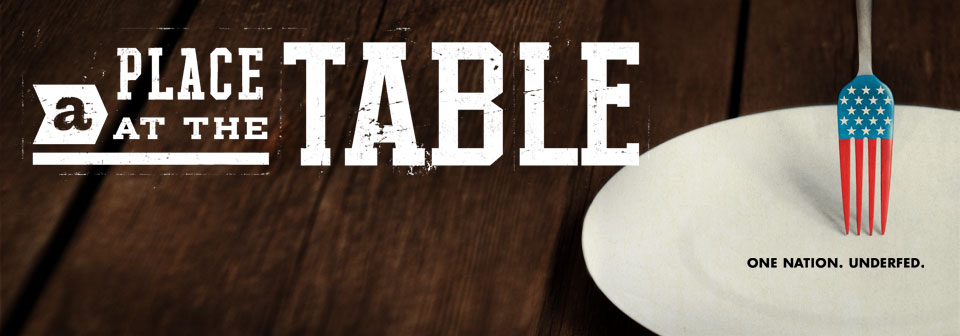A Place at the Table
reviewed by Ingela Hartman
 A Place at the Table opens by showing America’s abundant farmland – rolling wheat fields blowing in the wind, endless miles of corn and large prosperous farms. The images truly appear to capture the “land of plenty.” But as we know, appearances can be deceiving. The powerful documentary takes on the multilayered issue of hunger and attempts to give a voice to the 49 million Americans who don’t know where their next meal is coming from.
A Place at the Table opens by showing America’s abundant farmland – rolling wheat fields blowing in the wind, endless miles of corn and large prosperous farms. The images truly appear to capture the “land of plenty.” But as we know, appearances can be deceiving. The powerful documentary takes on the multilayered issue of hunger and attempts to give a voice to the 49 million Americans who don’t know where their next meal is coming from.
The film, which first debuted at this year’s Sundance Film Festival under the title Finding North, centers on three real-life stories of people grappling with hunger – Rosie, Tremonica and Barbie. Rosie is a lovable fifth-grader who has trouble concentrating in school because she isn’t getting enough to eat. Her family lives with her grandparents in a tiny rundown house in rural Colorado and relies on the support of food banks to survive. Despite the poor quality of food and nutrition those services provide, many other residents in her small town, even the town’s sole policeman, are struggling to make ends meet too and also depend on food donations to keep their families fed.
While it’s hard for many to imagine that hunger is an issue in a country where obesity is a crippling epidemic, directors Kristi Jacobson and Lori Silverbush explore this dichotomy by following a little boy from Mississipi named Tremonica. Mississippi simultaneously has the highest rate of obesity and the highest rate of food insecurity. Tremonica, a second-grader, looks nothing like the images of starving children with flies in their eyes that are seen in charity brochures. However, he is affected deeply by hunger, with health issues that have been intensified by poor nutrition. His family lives in a town that is forty miles from the nearest grocery store where fresh food is available, so his mother does most of their family’s grocery shopping at convenience stores and gas stations. His mother is on a very limited budget so lack of access to fresh food, coupled with the fact that the price of fruits and vegetables has gone up eighty percent since the 1980s, has caused Tremonica’s diet to consist predominantly of empty calories. Just like the food Rosie’s family receives from the food bank, this kind of diet causes him to be calorie rich, but nutrient deprived.
Barbie is an out-of-work single mother of two living in fast-paced Philadelphia. As she states in the film, “Hunger isn’t just someone in Africa that’s real skinny and you can see their ribs. It’s right here in the United States.” Her heartbreaking story highlights the challenges and struggles of qualifying for government assistance, and even with food stamps, she still has trouble sufficiently feeding her family. When Barbie lands a good office job, her assistance is immediately taken away, and she is back to struggling to keep her children fed. Either way, it seems like Barbie can’t win in this broken system.
Along with the stories of Rosie, Tremonica and Barbie that show the real people affected by food insecurity, the film also illustrates the government’s failure to meaningfully address this problem and takes on the hot button issues of school lunches, nutrition, and education. The film weaves in interviews with a variety of experts, including nutrition policy leaders and government representatives. It also incorporates insight from Top Chef’s Tom Colicchio and actor Jeff Bridges to add some celebrity power to the discussion.
While A Place at the Table shows several different examples of the devastating implications of hunger in America and the shortcomings of the current government system, it seems to conclude that more federal funding and assistance is the answer. There is no doubt that the film effectively presents the need for change, but it fails to include a more conservative voice on this issue. It does not take into account those who might argue against expanding nutrition programs, like food stamps, and those worried more aid will create greater dependency rather than just a stop-gap measure.
While some may feel the film bites off a few more issues than it can chew, overall, Jacobson and Silverbush skillfully encapsulate the complex and often confusing issue of hunger in America. They also do the very challenging task of promoting a political agenda while still managing to make the film feel heartfelt and moving.
Published December 3, 2012.
Raised in south central Pennsylvania, Ingela Hartman received her bachelor’s degree in Communications Studies with a minor in Electronic Filmmaking from Fairleigh Dickinson University in Madison, NJ. Her passion for writing and communications led her to a career in the fast-paced public relations industry, but after five years she decided to further her education. She is currently working on an M.F.A. in Writing at the Savannah College of Art and Design.
